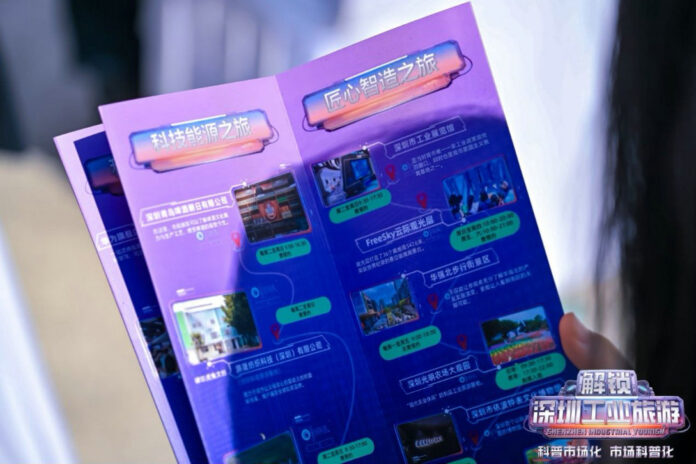
During the recent Chinese National Day and Mid-Autumn Festival holidays, Guangdong emerged as one of China’s top tourist destinations, attracting 65.176 million visits—a year-on-year increase of 11.5%—and generating 61.32 billion yuan in tourism revenue, up 14.2% from 2024, according to preliminary estimates from the Guangdong Provincial Department of Culture and Tourism. Beyond these numbers, a deeper trend is unfolding: Guangdong cities are embracing distinctive, culturally immersive tourism projects that reflect a new phase in the province’s tourism evolution.
Shenzhen, long known as China’s industrial capital, is leading this transformation through industrial tourism. The High Great Innovation Science Popularization Research and Industrial Tourism Base in Longgang District offers visitors hands-on experiences with drone operations, laser projects, and interactive exhibitions, allowing participants to explore the production and innovation processes of a national-level enterprise.
Established by High Great, which produces one million drones annually, the base integrates tourism, education, and interactive play, aiming to cultivate scientific literacy among youth while broadening public understanding of the low-altitude technology industry. Opened in 2023, it is expected to attract around 50,000 visitors this year, doubling last year’s numbers. This base is part of Shenzhen’s broader initiative to develop themed industrial tourism routes, including visits to high-tech manufacturers like BYD and DJI, the Daya Bay Nuclear Power Plant, and other innovative sites.
Experts note that Shenzhen’s industrial tourism offers more than sightseeing. “Industrial tourism allows visitors to engage deeply, participate directly, and experience the lifecycle of industrial products,” says Professor Li Zhou of Jinan University. This learning-oriented approach—combining exploration, creation, and observation—reflects a shift from traditional tourism to a culture of experiential learning, resonating with modern travelers seeking meaningful and interactive experiences. Shenzhen’s advantage lies not only in its industrial base, with comprehensive R&D, manufacturing, and branding chains, but also in its natural ecological environment, with mountains, parks, and sea connections that complement industrial experiences. During this summer vacation alone, Shenzhen’s major industrial tourism sites welcomed around six million visitors.
Yet industrial tourism in Shenzhen is still in its early stages, with most visitors being corporate groups or students. Authorities recognize the need to expand to wider audiences and to transition from “simple visits” to immersive experiences that showcase full product lifecycles—from R&D to testing—while leveraging enterprises with unique industrial assets. Plans are underway to connect factories, exhibition halls, heritage sites, and educational centers into premium thematic itineraries, ensuring sustainable growth and broader appeal. Companies like Gaoju Innovation are also expanding content to reflect technological advancements and collaborate nationwide, creating an ecosystem for continuous innovation and enriched visitor experiences.
Shenzhen’s story is part of a larger movement across Guangdong, where cities are reinventing cultural tourism to emphasize creativity, lifestyle, and niche experiences rather than merely relying on scenic spots or broad-based attractions. Foshan, for instance, has transformed its dragon boat culture into a citywide tourism phenomenon. This year, it established a five-district dragon boat race matrix, including the Foshan F3 Dragon Boat Super League and the region’s largest five-person dragon boat race. By combining these events with gastronomic experiences, specialty markets, and intangible cultural heritage like fire dragon dances, Foshan created immersive experiences that drew 4.5839 million visitors over the holiday, generating 4.042 billion yuan in revenue.
Similarly, Shantou has positioned its culinary heritage as a central attraction rather than a supplementary feature. Visitors to the 2025 Shantou Cultural Tourism Carnival could participate in hands-on food-making, from rice cakes to oyster omelets, while exploring more than 130 branded food stalls offering local specialties. The city welcomed 4.502 million tourists, up 17.2% from the previous year, with tourism revenue increasing 20.1% to 2.87 billion yuan. Meanwhile, Meizhou’s rural eco-tourism has captured attention through picturesque villages, countryside bookstores, taverns, and unique homestays. Long’an Village and Zhuangzhu Village attracted visitors seeking rustic charm and immersive rural experiences, contributing to 2.262 million visits and 2.128 billion yuan in tourism revenue.
Experts highlight that the success of these projects stems from a new strategy: collaboration among distinctive tourism initiatives to appeal to diverse visitor groups and expand consumption markets. Shenzhen’s industrial tourism sets a benchmark for learning and innovation, while Foshan and Shantou leverage local culture and gastronomy to enrich visitor experiences. Together, these cities embody the Greater Bay Area’s approach of “differentiated development and coordinated synergy,” offering a diverse and complementary tourism landscape.
Underlying this shift is a broader rethinking of cultural tourism. Professor Wu Zhicai of South China University of Technology observes three key trends: a move from resource dependency to creativity-driven tourism, a shift from sightseeing to lifestyle and experiential consumption, and a transition from mass marketing to precise niche targeting. The emphasis is on preserving local culture dynamically, providing interactive experiences, building sustainable cultural industries, and creating strong cultural brands. Digital technologies and online platforms further empower cities to offer immersive experiences, reach target audiences, and conduct innovative marketing.
In this competitive landscape, success depends not on resource abundance but on creativity, local knowledge, and immersive experiences. Cities are encouraged to build attractions that feel authentic, unique, and refined, engaging residents and visitors alike. Collaborative mechanisms involving governments, businesses, and local communities are essential for sustaining these projects, ensuring that tourism development enhances urban identity and drives industrial growth.
As Guangdong demonstrates, the province is no longer simply a destination for sightseeing; it has become a dynamic arena where culture, technology, and lifestyle converge. From Shenzhen’s industrial innovation and Foshan’s dragon boat extravaganzas to Shantou’s culinary immersion and Meizhou’s rural retreats, visitors can now explore a rich tapestry of experiences that blend tradition with modernity. These initiatives not only elevate Guangdong’s appeal to domestic and international travelers but also redefine what cultural tourism is—a realm where learning, play, and discovery intersect, creating memories that endure far beyond the holiday season.
Source: szdushiquan, luoohu, High Great, CGTN



